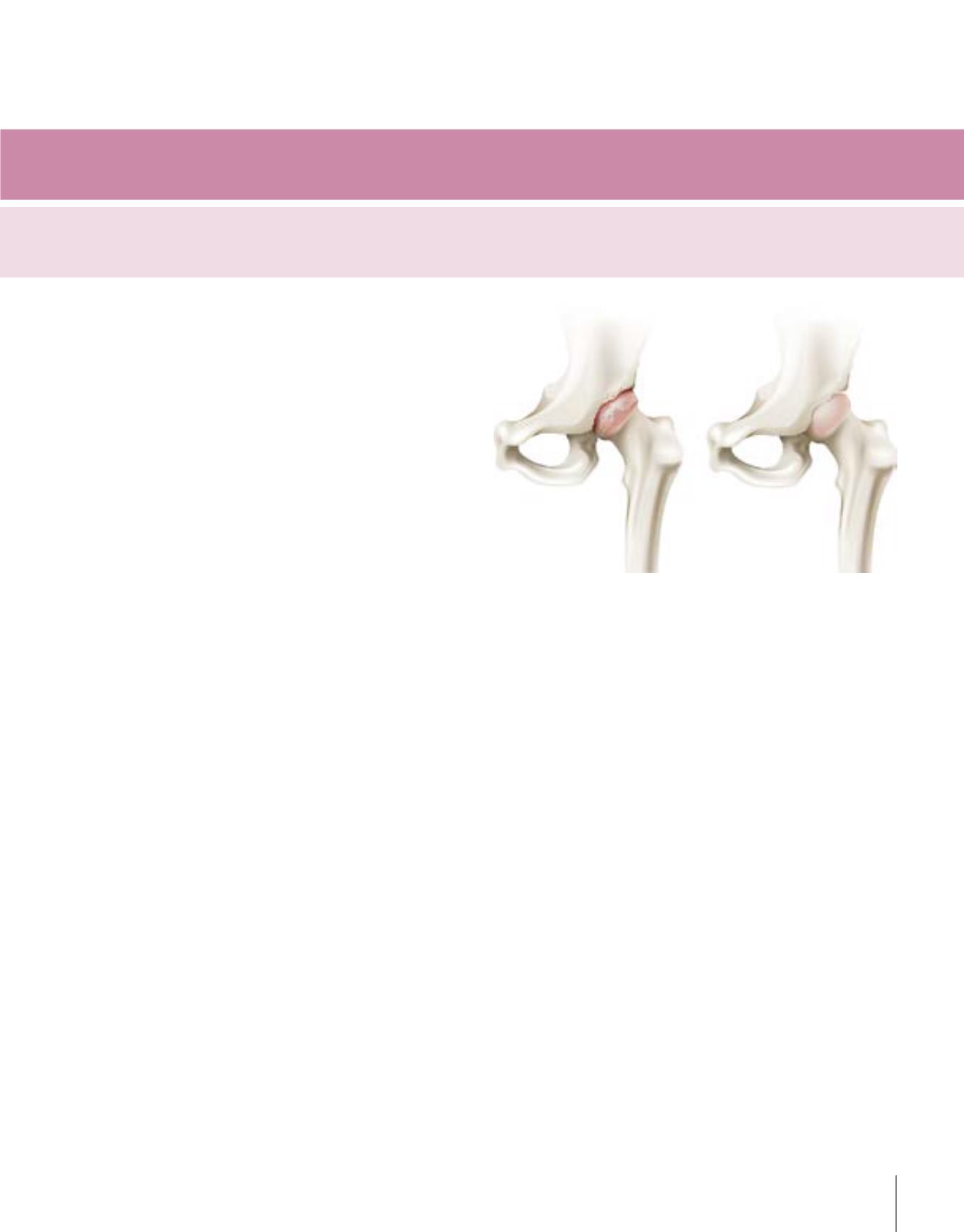
93
İlerleyen dönemlerde bir
baston veya koltuk değneği
ile kalçaya gelen yükün
azaltılması öneriliyor. Hastalığın
ilerlediği dönemde kesin tedavi
cerrahi yöntemlerle mümkün
olabiliyor. Uyluk kemiğinin üst
bölgesinde kemiğe yapılan
kesilerle, açısal problemlerin
düzeltilmesi ve kıkırdağın
sağlam kısmının eklemi
oluşturmasının sağlanması
(femoral osteotomiler) eskiden
beri uygulanan ve uygun
hastalarda iyi sonuçlar veren
cerrahi yöntemler. Bu tip cerrahi
girişimler hastaların protez
ameliyatını öteleyebiliyor.
Kalça eklemi kireçlenmesi veya
kıkırdak dokusunun erimesinin
tedavisinde, günümüzde en
etkili ve yaygın yöntem kalça
artroplasti ameliyatları. Bu
yöntemde bozulmuş olan kalça
eklemi tümden çıkarılarak
yerine yapay bir kalça eklemi
takılıyor. Bu yapay eklem; leğen
kemiğindeki yuvanın oyularak
içine oturtulan metal kılıf, bu
kılıfın içini döşeyen plastik veya
seramik parça ile uyluk kemiği
içine yerleştirilen bir metal
sap ve sapın üzerine monte
edilen metalik veya seramik bir
topuzdan ibaret. Yuvayı döşeyen
ve topuzu oluşturan materyal;
metal-metal, metal-plastik,
seramik-seramik olabiliyor.
Seramik protezler dayanma
süreleri uzun olduğundan
genç hastalarda tercih ediliyor.
Metal-metal protezler de
dayanıklı ve mekanik olarak
daha sabit protezler. Ancak
metal aşınmasına bağlı vücutta
metal birikimine neden oldukları
yönünde çok sayıda yayın
bulunuyor. Bazı gruplar ise
bu metal birikiminin önemli
olmadığını iddia ediyor.
Eskiden protezler kemik
çimentosu ile uygulanırken,
günümüzde çimentosuz ve
kemiğe tutunan protezler
tercih ediliyor. Kalça artroplasti
ameliyatında genel kabul,
ameliyatın 60-65 yaş üzerindeki
hastalara yapılması. Bu tercihin
nedeni zamanla protezin
parçalarının aşınması veya
kemik içerisindeki protezin
gevşemesine bağlı olarak
tekrar ameliyat gereksiniminin
doğması. Ancak bu kabul genç
hastalarda protez ameliyatı
yapılamayacağı anlamına
gelmiyor. Genç yaşta şiddetli
kalça eklemi kireçlenmesi
olan hastaların daha etkin
ve normale yakın yaşamaları
için bu ameliyat büyük yarar
sağlıyor.
Protez ameliyatlarında; ameliyat
sonrası erken dönemde protezin
gevşemesi, ameliyat sırasında
damar - sinir yaralanmaları,
protezin yerleştirilmesi sırasında
kemikte kırılma, fazla kan
kaybı, ameliyat sonrasında
protez çevresinde enfeksiyon
gelişmesi, tromboemboli
(bacak damarlarındaki pıhtının
diğer organlara giderek
buradaki damarları tıkaması)
ya da anestezi ile ilgili bazı
komplikasyonların görülme
olasılıkları bulunuyor.
joint consists of a metal casing
that is placed on the socket in the
hipbone, the plastic or ceramic
part that covers the interior of
this casing, a metal shaft placed
inside the femur and a metallic
or ceramic knob that is placed
on this shaft. The interior of the
casing and the material of the
knob can be metal-metal, metal-
plastic or ceramic-ceramic.
Since the working life of ceramic
prosthesis is long, they are
preferred for younger patients.
Metal-metal prosthesis are
stronger and are mechanically
more stable. However, there are
many publications indicating that
they cause metal accumulation
in the body due to metal wear.
Whereas some groups of
people proclaim that this metal
accumulation is not significant.
In the past, prosthesis were
applied with bone cement
but today prosthesis that are
cement-free and fixed on the
bone are preferred. The general
acceptance criterion for hip
arthroplasty is that the operations
are made on patients over the
age of 60-65. The reason for this
preference is the fact that another
treatment might be necessary
due to the wear and tear of the
prosthesis parts over time or
the possibility of these parts
coming loose inside the bone.
However, this does not mean
that prosthesis surgery cannot
be made on young patients. This
operation is very beneficial for
young patients with intensive hip
joint arthritis.
Prosthesis surgeries have various
possible complications such as
the loosening of the prosthesis
during the early period following
the surgery, vein – nerve injuries
that can take place during the
surgery, bone fracture during
the placement of prosthesis,
excessive loss of blood, infection
development around the
prosthesis following the surgery,
thromboembolism (emboli in
veins in other parts of the body
as a result of the clotting in the
leg veins) or various anesthesia
related complications.


